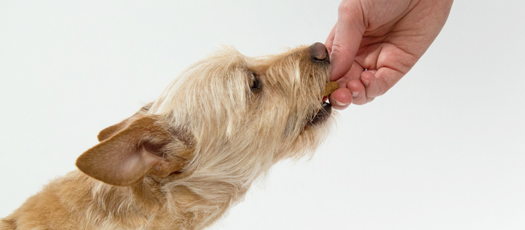
Giving rescue dogs a sense of security
Wherever they may come from – Romania, Greece, Portugal – they all need our help. These days, rescue dogs come to Germany from all over Europe. When they arrive, they all want a safe, secure place to call home and a loving, caring family. Many dog owners find rescue dogs’ stories heartrending. They arouse our protective instincts and prompt us to try to make a positive impact in the world and help a creature in need. But there are often some difficulties when it comes to integrating these dogs and keeping them as pets in our day-to-day lives. This article offers a few tips and explains how you can give your furry friend support and a greater sense of security in everyday life.
Why do rescue dogs need more security and support in their day-to-day lives?
In many cases, dogs who have been treated poorly or lived on the street do not trust humans, or they have lost their trust in humans due to mistreatment, neglect, or even because they have been hurt or have been victims of cruelty. But trust in humans is essential if a dog is to settle in to a new life after adoption. Especially because rescue dogs have a harder time settling in to a new environment, a secure, stable bond between human and dog and a confident bonding partner are crucial.
Depriving a dog of experiences leaves lasting scars
Puppies between the ages of four and 20 weeks undergo what is known as a “socially sensitive” phase, when they absorb all of the stimuli and experiences to which they are exposed and store them away deep down for their future lives. During this time, a puppy normally forms new nerve cells that forge connections with each other. If they are deprived of certain experiences during this time, like the opportunity to get to know other people, dogs, noises, materials, and environments, puppies cannot form new nerve connections, since the necessary impulses are not transmitted to the brain. As a result, animals who have been deprived in this way have deficits in their brain structure that make it harder for them to find their way around in a complex environment later in life and respond flexibly to changing conditions or deal independently with the world around them. This frequently leads to uncertain behavior and even to chronic anxiety and a feeling of permanent stress. As they search for an outlet for this pent-up tension, dogs soon learn to bark and even to behave aggressively to keep other humans, dogs, and unfamiliar situations at bay and get away from them. This self-defense mechanism can become the dog’s strategy.
Lowering a dog’s stress level through relaxation exercises
Since most rescue dogs have faced deprivation of one kind or another, it is important for you as an owner to know how to give your dog the sense of security it so urgently needs from you.
As the first step, it is advisable to lower your dog’s stress level. Dogs who have been harmed by deprivation are often highly excitable and constantly nervous or tense and in many cases cannot calm themselves down. This is one place where you as an owner can be a big help!
The most basic step should be to create a safe haven where your dog can go anytime. This should be a place where the dog can be undisturbed, without people talking to it, looking at it, or touching it. Many dogs have never experienced a safe haven like this until this point in their lives. Since this is a new concept, your dog should learn that this place is somewhere it can feel completely safe. Many dogs prefer cave-like spots, like boxes or igloos, since they offer more protection and are a smaller “target.” Some also like to hide under the table. Your dog’s safe haven should preferably be set up in a calm and quiet corner of your home, away from windows, doors, or entryways where it may have to deal with further stimuli, like pedestrians passing by or noise from the stairwell.
Good relaxation training also helps to lower your dog’s ongoing stress level. The more relaxed your dog is, the less stressed it will be in responding to stimuli, and the less it will need to find an outlet for its tension. If your dog likes to be touched, you can start with massage. Simply stroke your dog’s back gently with the palm of your hand, carefully taking its skin between your thumb and forefinger and slowly massaging down the length of the spine to the tailbone. This area is the site of many nerve endings, and massage often brings a relaxed sigh and exhalation from the dog. When giving your dog a massage, it is important to make sure you are in a calm state yourself.
Essential oils such as lavender oil can also help to relax both you and the dog. Simply place a few drops of the oil in an aroma diffuser or on a piece of cloth. If the fragrance is always offered in conjunction with a relaxing massage, sooner or later the dog will come to associate it with the upcoming feeling of relaxation. You can then turn to this scent for support in many other everyday situations.
In acute situations, such as when traveling by car or when your dog has to stay alone or has a tough event coming up, rescue drops – a special Bach flower remedy – are a good option. Simply place a few drops on the back of your hand or give them to the dog directly by nose before the event. Rescue drops also help your dog to calm down and relax.
Establish fixed structures and routines in everyday life
Since dogs who have been deprived of experiences often have trouble applying what they have learned in the past to new situations, they also have a harder time settling in if their day-to-day lives involve constant change. You can give your dog lasting support in this area by incorporating fixed structures and routines into your everyday life. If you do this, your dog knows what to expect, so it will not feel helpless and stressed out as often, which in turn lowers its stress and excitement levels. The most helpful thing in this regard is a fixed daily schedule, especially fixed routines around going for walks.
Walks can be a particular challenge, since we as owners have little to no influence over the stimuli we may encounter and other people who may approach with their dogs. Take your time and explore your dog’s surroundings with it. You might look at a leaf or listen to the noises around you. Show your dog that you perceive these stimuli, too, and that it is not alone with them.
If you encounter other people out with their dogs while on your walk, beware of misplaced ambition. You should get your dog out of any situation as soon as it feels uncomfortable or afraid. Once a dog is stressed, stress hormones such as cortisol, adrenaline, and noradrenaline are released. These hormones block learning in the dog’s brain. This means that the dog is not receptive to being spoken to during the dog encounter at any rate. You will give your dog a greater sense of security and trust if you distance yourself from this stimulus at first. Once your dog is in a calmer state for a longer period, you can start training for these situations as well.
Ensuring success is also highly advisable in terms of your bond with the dog. Any and all situations where your dog manages to cope will give it a sense of security and the feeling of having done something right. Activities that really boost a dog’s sense of confidence include doing tricks together and Degility, an obstacle course that a dog and its owner run at the dog’s own pace on various surfaces, without any sense of competition at all.
Mood transfer: How do you feel?
When it comes to conveying a sense of security, you and your mood as the dog owner are also crucial. After all, you can only help your dog to feel secure if you feel secure yourself. In many cases, though, we owners get caught up in our rescue dogs’ past misfortunes, which can cause us to feel sympathy, sorrow, and concern. But a negative mood will not help your dog. What does help is a confident, self-assured bonding partner who exudes a strong, positive mood.
For that reason – and not least for you yourself – you should make a habit of working on your mindset, making your mood a priority. One scientifically proven way to lower your own stress level and bring more gratitude and attention to your day-to-day life is meditation. Try to take five minutes for yourself every day, focusing on all the positive aspects of your life was you meditate. It won’t take long before you notice a change in your mood.
To calm down in acute situations and shift from an uncertain mood to a secure one, the “4-7-8” breathing technique can help. In this technique, you take a deep breath through your nose all the way into the abdomen for four seconds, hold your breath for seven seconds, and then spend eight seconds noisily exhaling through the mouth. Especially during walks, this form of breathing has been a big help to many dogs and their owners when it comes to keeping a level head when other dogs approach. Holding your breath gives the oxygen time to reach your cells, which helps you to think more clearly, act with more confidence, and display greater self-assertion and poise, thereby making better decisions for yourself and your dog as a team.


